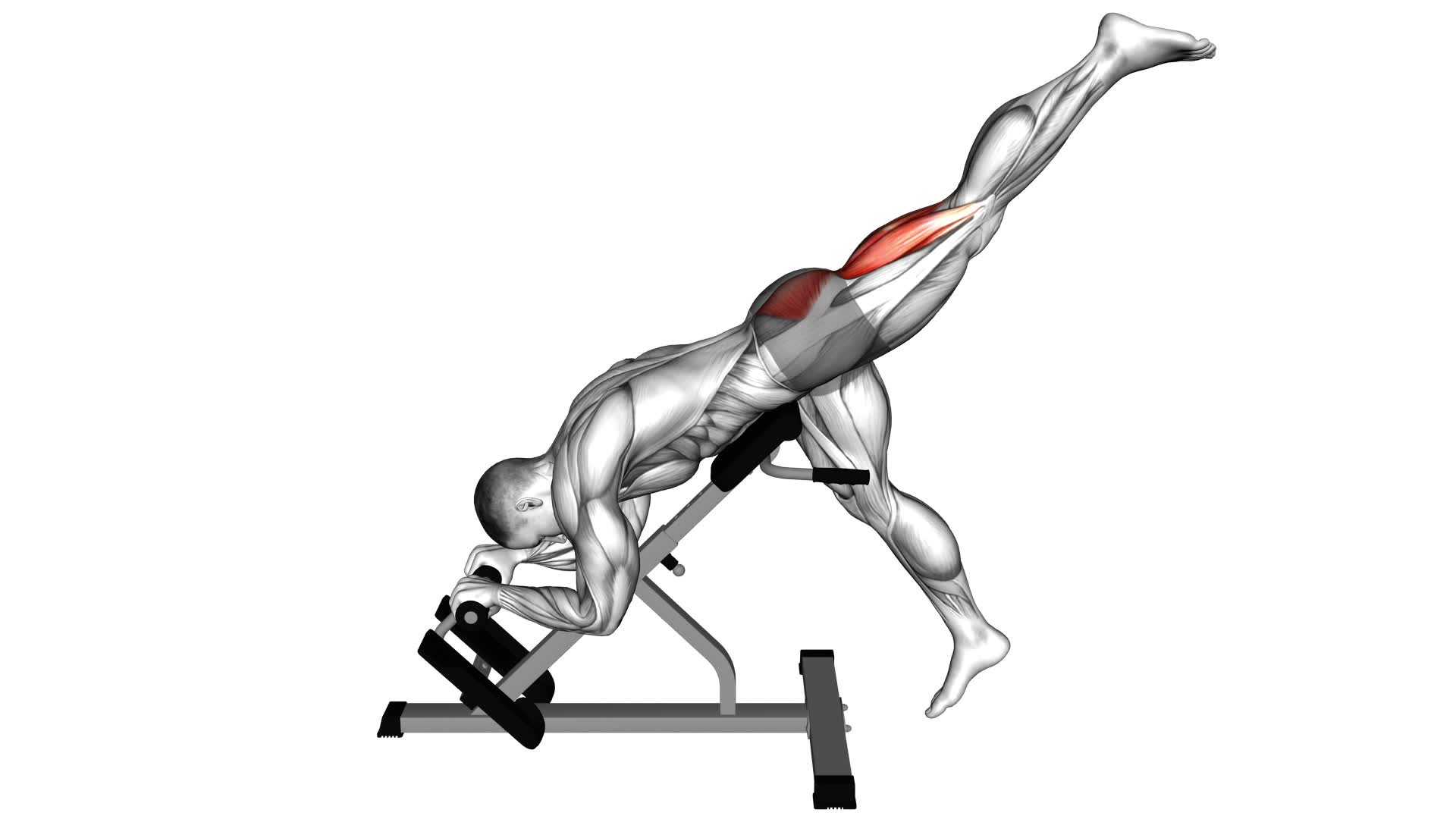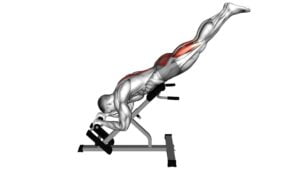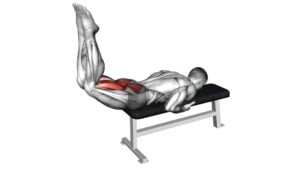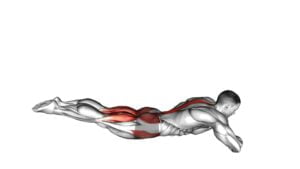45 Degrees Single Leg Reverse Hyperextension – Video Exercise Guide & Tips

Are you looking for a challenging exercise that targets your glutes and hamstrings? Look no further than the 45 degrees single leg reverse hyperextension.
Watch This Exercise Video
This video exercise guide will show you the proper form and technique to maximize the effectiveness of this exercise. Whether you're a beginner or an advanced fitness enthusiast, we've got modifications for all fitness levels.
Avoid common mistakes and get ready to feel the burn with this powerful exercise.
Key Takeaways
- Increased glute activation
- Improved lower back strength
- Targets gluteus maximus, hamstrings, and erector spinae muscles
- Maintaining proper form and technique is crucial to avoid injury and maximize effectiveness.
Benefits of the 45 Degrees Single Leg Reverse Hyperextension
You can experience increased glute activation and improved lower back strength by performing the 45 Degrees Single Leg Reverse Hyperextension. This exercise specifically targets the gluteus maximus, hamstrings, and erector spinae muscles. By isolating these muscles, you can achieve a more effective workout and develop greater muscle activation.
The 45 Degrees Single Leg Reverse Hyperextension is a variation of the traditional reverse hyperextension exercise. By performing this exercise at a 45-degree angle, you can increase the intensity and target different muscle fibers. This variation also helps to engage the stabilizing muscles of the core and lower back, leading to improved overall strength.
When performing the 45 Degrees Single Leg Reverse Hyperextension, it's important to maintain proper form and technique. Start by lying face down on a hyperextension bench with your legs extended behind you and your hips positioned at a 45-degree angle. Engage your core and lift one leg towards the ceiling, keeping it straight throughout the movement. Slowly lower your leg back down and repeat on the other side.
Incorporating the 45 Degrees Single Leg Reverse Hyperextension into your workout routine can lead to increased glute activation and improved lower back strength. By trying different variations and incorporating proper form, you can target specific muscle groups and achieve optimal results.
Proper Form and Technique for the Exercise
Maintain proper form and technique while performing the 45 Degrees Single Leg Reverse Hyperextension exercise to effectively target the gluteus maximus, hamstrings, and erector spinae muscles and improve lower back strength.
To ensure proper alignment and muscle activation, start by lying face down on a hyperextension bench with your hips positioned at the edge. Hook your feet under the footpads and place your hands behind your head. Engage your core and lift one leg off the ground, keeping it straight and in line with your body. Keep your spine neutral and avoid arching your back.
As you lift your leg, exhale and raise your upper body until it's in line with your legs. Pause briefly at the top and then slowly lower yourself back down to the starting position while inhaling. Maintain control throughout the movement and avoid using momentum to lift your body.
By maintaining proper form and technique, you can ensure that the targeted muscles are effectively engaged and that your lower back is strengthened.
Next, we'll discuss modifications for different fitness levels to help you progress in your training.
Modifications for Different Fitness Levels
To accommodate individuals of varying fitness levels, modifications can be made to the Degrees Single Leg Reverse Hyperextension exercise. Here are some options to consider:
- Adjust the range of motion: Start by performing the exercise with a smaller range of motion, gradually increasing it as you get stronger and more comfortable. This allows you to tailor the exercise to your current fitness level.
- Use both legs: If you find it challenging to perform the exercise with a single leg, try using both legs instead. This modification allows for more stability and can be a great starting point for beginners.
- Use a resistance band: Adding a resistance band can increase the difficulty of the exercise. Attach the band to your ankles or secure it around a fixed object, such as a sturdy post or weight bench. The band provides extra resistance, helping to strengthen your glutes and hamstrings.
- Explore alternative exercises: If the Degrees Single Leg Reverse Hyperextension is too advanced for your current fitness level, there are alternative exercises you can try. Some options include glute bridges, hamstring curls, or deadlifts. These exercises target similar muscle groups and can be modified to suit your progression levels.
Remember to listen to your body and progress at a pace that feels challenging yet manageable. Consulting with a fitness professional can also help ensure that you're performing the exercises correctly and safely.
Common Mistakes to Avoid
Continuing from the previous section on modifications, it's important to be aware of common mistakes to avoid when performing the Degrees Single Leg Reverse Hyperextension exercise. By avoiding these mistakes, you can't only prevent injuries but also maximize the effectiveness of the exercise.
One common mistake is using too much weight or resistance. It's crucial to start with a weight or resistance level that's appropriate for your fitness level. Using too much weight can put unnecessary strain on your lower back and increase the risk of injury.
Another mistake to avoid is using improper form. When performing the exercise, make sure to keep your core engaged and your back straight. Avoid arching your back or rounding your shoulders, as this can lead to discomfort and potential injuries.
For advanced users, a common mistake is neglecting variations. To challenge yourself and continue progressing, try incorporating variations such as adding ankle weights or performing the exercise on an unstable surface like a Bosu ball. These variations can help target different muscles and enhance the overall effectiveness of the exercise.
By being mindful of these common mistakes and making the necessary adjustments, you can ensure a safe and effective workout.
Now, let's move on to the next section where we'll discuss tips for maximizing the effectiveness of the Degrees Single Leg Reverse Hyperextension exercise.
Tips for Maximizing the Effectiveness of the Exercise
To maximize the effectiveness of the Degrees Single Leg Reverse Hyperextension exercise, you should incorporate proper breathing techniques. This will help you maintain stability and engage the appropriate muscles throughout the movement.
Here are some tips to help you get the most out of this exercise:
- Focus on form: Ensure that your body is properly aligned and your core is engaged. This will help you target the intended muscle groups and reduce the risk of injury.
- Gradually increase weight: Start with a comfortable weight and gradually increase it over time. This will challenge your muscles and help you see better results.
- Explore variations: To target different muscle groups, you can try variations of the exercise. For example, you can perform the exercise with both legs or add resistance bands for an extra challenge.
- Listen to your body: Pay attention to how your body feels during the exercise. If you experience any pain or discomfort, make adjustments or consult a fitness professional for guidance.
Sample Workout Routine Incorporating the 45 Degrees Single Leg Reverse Hyperextension
To optimize your workout routine, regularly incorporate the 45 Degrees Single Leg Reverse Hyperextension exercise for maximum results. This exercise not only targets your glutes but also engages your hamstrings and lower back. To add variation to your routine, you can try different 45 degrees single leg reverse hyperextension variations.
For example, you can perform the exercise with a resistance band around your ankles to increase the intensity. Another variation is to perform the exercise on a stability ball, which challenges your core stability while working your glutes.
To create a sample workout routine incorporating the 45 Degrees Single Leg Reverse Hyperextension, start with a dynamic warm-up to activate your muscles. This can include exercises like leg swings and hip circles. Then, perform a compound exercise such as squats or lunges to further engage your glutes.
Next, incorporate the 45 Degrees Single Leg Reverse Hyperextension exercise for glute activation. Aim for 3 sets of 10-12 repetitions per leg. Continue your routine with other lower body exercises such as deadlifts and step-ups. Finally, finish with stretching exercises to cool down and prevent muscle soreness.
Frequently Asked Questions
How Many Sets and Reps Should I Do for the 45 Degrees Single Leg Reverse Hyperextension?
To get the most out of the 45-degree single leg reverse hyperextension, it's important to find the right sets and reps for you. Start with 2-3 sets of 10-12 reps on each leg, and adjust as needed based on your fitness level and goals. This exercise is great for targeting your glutes and hamstrings. Remember, there are variations of this exercise, so feel free to explore different angles and resistance levels to challenge yourself even more.
Can the 45 Degrees Single Leg Reverse Hyperextension Help Improve My Balance?
The 45 degrees single leg reverse hyperextension is a great exercise for improving balance. By targeting the muscles in your lower back, glutes, and hamstrings, this exercise helps strengthen and stabilize your core.
Single leg exercises, like this one, are known for their added challenge of balance and coordination. Incorporating them into your workout routine can have numerous benefits, including improved balance, increased stability, and enhanced overall strength.
Is It Necessary to Use a Specific Type of Equipment for This Exercise?
To answer your question, yes, there are different types of equipment you can use for the single leg reverse hyperextension exercise. Some options include a hyperextension bench, stability ball, or even just using your body weight.
These variations can help target different muscles and add variety to your workout routine. It's not necessary to use a specific type of equipment, but it can enhance your workout and provide different challenges for your balance and strength.
Are There Any Pre-Existing Conditions or Injuries That May Make This Exercise Unsuitable for Me?
If you have any pre-existing conditions or injuries, it's important to consider whether the Degrees Single Leg Reverse Hyperextension exercise is suitable for you. Certain conditions, such as lower back issues or knee problems, may make this exercise unsuitable or require modifications.
It's always best to consult with a healthcare professional or a qualified trainer who can assess your specific situation and recommend alternative exercises that are safer and better suited to your needs.
Can the 45 Degrees Single Leg Reverse Hyperextension Be Incorporated Into a Full-Body Workout Routine?
Yes, the 45-degree single leg reverse hyperextension can definitely be incorporated into a full-body workout routine. By adding this exercise, you can target your glutes, hamstrings, and lower back while also engaging your core for stability.
The single leg variation adds an extra challenge and helps improve balance and unilateral strength. Incorporating this exercise can enhance your overall lower body strength and stability, making it a valuable addition to your workout routine.
Conclusion
Incorporating the 45 degrees single leg reverse hyperextension into your workout routine can provide numerous benefits, such as strengthening your lower back, glutes, and hamstrings.
By following proper form and technique, avoiding common mistakes, and making modifications for different fitness levels, you can maximize the effectiveness of this exercise.
Remember to always consult with a fitness professional to ensure you're performing the exercise correctly and safely.

Author
Years ago, the spark of my life’s passion ignited in my mind the moment I stepped into the local gym for the first time. The inaugural bead of perspiration, the initial endeavor, the very first surge of endorphins, and a sense of pride that washed over me post-workout marked the beginning of my deep-seated interest in strength sports, fitness, and sports nutrition. This very curiosity blossomed rapidly into a profound fascination, propelling me to earn a Master’s degree in Physical Education from the Academy of Physical Education in Krakow, followed by a Sports Manager diploma from the Jagiellonian University. My journey of growth led me to gain more specialized qualifications, such as being a certified personal trainer with a focus on sports dietetics, a lifeguard, and an instructor for wellness and corrective gymnastics. Theoretical knowledge paired seamlessly with practical experience, reinforcing my belief that the transformation of individuals under my guidance was also a reflection of my personal growth. This belief holds true even today. Each day, I strive to push the boundaries and explore new realms. These realms gently elevate me to greater heights. The unique combination of passion for my field and the continuous quest for growth fuels my drive to break new ground.







